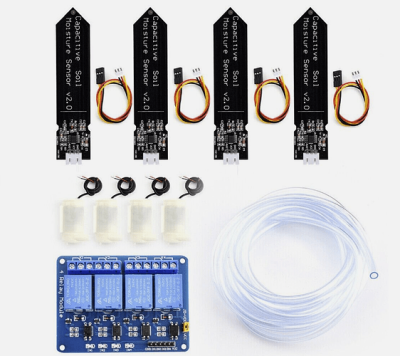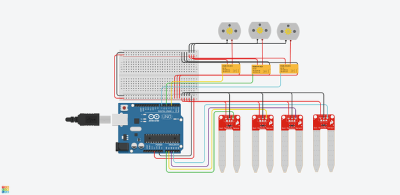Inhaltsverzeichnis
Arduino
Allgemein
Analoges out
Projekte
Flipper
Joystick
Für Leonardo oder Micro (nur die verwalten den USB-Anschluss selbst und könnten dadurch Keyboards, Joysticks etc. emulieren).
Quelle1)
Out of the box the Arduino Leonardo and the Arduino Micro appear to the host computer as a generic keyboard and mouse. This article discusses how the Arduino Leonardo and the Arduino Micro can also appear as one or more generic Game Controllers or Joysticks. The Arduino Joystick Library Version 2.0 can be used with Arduino IDE 1.6.6 (or above) to add one or more joysticks (or gamepads) to the list of HID devices an Arduino Leonardo or Arduino Micro (or any Arduino clone that is based on the ATmega32u4) can support. This will not work with Arduino IDE 1.6.5 (or below) or with non-32u4 based Arduino devices (e.g. Arduino UNO, Arduino MEGA, etc.).
The joystick or gamepad can have the following features:
- Buttons (default: 32)
- Up to 2 Hat Switches
- X, Y, and/or Z Axis (up to 16-bit precision)
- X, Y, and/or Z Axis Rotation (up to 16-bit precision)
- Rudder (up to 16-bit precision)
- Throttle (up to 16-bit precision)
- Accelerator (up to 16-bit precision)
- Brake (up to 16-bit precision)
- Steering (up to 16-bit precision)
These features are configured using the Joystick_ class’s constructor.
The latest build of Version 2.0 of the Arduino Joystick Library can be downloaded from the following GitHub repository:
https://github.com/MHeironimus/ArduinoJoystickLibrary/tree/version-2.0
The library can also be downloaded directly using the following: https://github.com/MHeironimus/ArduinoJoystickLibrary/archive/version-2.0.zip
Quelle2)
The Arduino Joystick Library (a.k.a. Game Controller library) used in the Instructable provides the following:
- X, Y, and Z axis
- 32 buttons
- X, Y, and Z axis rotation
- Rudder
- Throttle
- 2 Point of View Hat Switches
The latest version of the Arduino library that allows the Arduino Leonardo and Micro to appear as a Game Controller can be downloaded from the following GitHub repository:
https://github.com/MHeironimus/ArduinoJoystickLibrary
This GitHub repository actually contains three different versions of the Arduino Joystick Library:
- Joystick - Causes the Arduino to appear as single Game Controller
- Joystick2 - Causes the Arduino to appear as two, simple Game Controllers
- Joystick3 - Causes the Arduino to appear as three, simple Game Controllers
Bewässerungsautomatik
4 Pumpen, 4 Feuchtigkeitssensoren, Board mit 4 Relais bei Ali für cs 13 EU.
Quelle3)
const byte channels = 3;
const byte relayPin[channels] = {3, 5, 7}; // Pins controlling the relays
const byte moisturePin[channels] = {A0, A1, A2}; // Analog pins connected to the moisture sensors
const int threshold[channels] = {350, 400, 400}; // Adjust these values based on your soil conditions
const byte moisturePinTorr = A3; // Analog pins connected to the moisture sensors
const int thresholdTorr = 530; // Adjust these values based on your soil conditions
void setup() {
Serial.begin(9600);
for (byte c=0; c<channels; c++) {
pinMode(moisturePin[c], INPUT);
pinMode(relayPin[c], OUTPUT);
}
pinMode(moisturePinTorr, INPUT);
}
void loop() {
int moistureLeveltorr = analogRead(moisturePinTorr);
for (byte c=0; c<channels; c++) {
int moistureLevel = analogRead(moisturePin[c]);
if (moistureLevel > threshold[c] && moistureLeveltorr < thresholdTorr) {
Serial.print("Soil moisture ");
Serial.print(c);
Serial.println(" is DRY => activating pump");
digitalWrite(relayPin[c], LOW); // Turn on the pump
// Decide how long the pump should run (e.g., 5-10 seconds)
int pumpRunTime = random(15, 19); // Random time between 5 and 10 seconds
delay(pumpRunTime * 1000); // Convert to milliseconds
3 pumps and 3 relay coils are too much load on USB supply, you need a separate 5 volt supply of at least 2 Amps. Also, you should have a kickback suppression diode in parallel with each pump, cathode (end with band) toward + (positive) voltage.

